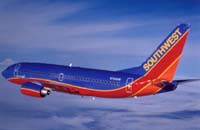Bad weather or pilot error? Here's one theory

I was talking with a friend the other day about the recent crash of Southwest flight 1248 at Midway Airport in Chicago. My friend is a 737 captain for another airline. Southwest's entire fleet consists of Boeing 737s.
According to my friend, who was flying into Chicago O'Hare at around the same time that the Southwest flight was attempting to land at Midway, pilot error may be the most likely explanation for the accident that left a 6-year-old boy dead.
Here's what I learned:
Midway Airport has some of the shortest runways anywhere. The runway on which flight 1248 was attempting to land is not much longer than 6,500 feet with virtually no buffer zone between the end of the runway and the edge of the airport. Runways at most major airports are nearly twice as long with a buffer zone of at least 1,500 feet. In good weather with no wind, a 737 requires nearly 5,800 feet to land and come to a stop. Most times, aircraft land (and take off) into the wind. It gives the plane lift while taking off and allows it to slow more readily when landing. It's the way things usually are done.
Well, according to my friend, flight 1248 was landing with a 13 knot TAILwind, meaning the wind was blowing from behind the aircraft. Now, 13 knots may not sound like much (it equates to about 15 mph), but for each knot of windspeed, a Boeing 737 requires an additional 150 feet to stop. Similarly, when landing into the wind, each knot of windspeed reduces the landing distance by 150 feet. So one easily can understand why it is a much better idea to land into a headwind, especially with a short runway.
So, in doing the math, we find that a 13 knot tailwind would have added about 1,950 feet to the landing distance. And it's also important to note that, according to my friend, Boeing's recommended threshold for landing with a tailwind is...10 knots!
So, we had a very short runway. We had an aircraft landing with a strong tailwind. We had snowy conditions.
Anything else? Oh, yeah. We had a flight that was already late landing because it had to circle Midway until the weather cleared up a bit.
Anything else? Yep. The Southwest terminal was near the far end of the runway that the pilot elected to land on.
Anything else? You betcha. Southwest prides itself - and advertises it quite vociferously - as the "on-time airline." Its business model relies on quick turnarounds of aircraft, usually less than 30 minutes between touchdown of one flight and wheels-up for the next flight.
Are you beginning to get the picture here? Is it becoming clear why my friend, the 737 captain, believes the accident may have been due to pilot error? I thought so.
We've heard some talk in the media about reverse thrusters and autobrakes. In fact, a story in today's Chicago Sun-Times says that the autobrakes were set to maximum, apparently in violation of Southwest policy. You know why they were set to maximum? Most likely because the captain knew he was going to have trouble bringing the aircraft to a stop with a strong tailwind, so he decided to use every tool at his disposal. It wasn't enough.
The NTSB will take its time examining all of the evidence to determine what caused the accident. Most likely, it will take close to a year before releasing its findings. The good news, if anything, is that there weren't more fatalities. It could have been much worse.
But the eventual story here may be how Southwest Airlines, long trumpeted as the profitable darling of an otherwise unprofitable industry, sometimes compromises passenger safety in order to retain its vaunted "on-time airline" tagline. Stay tuned...
12/15/05 UPDATE: On the local Dallas news this evening, the issue of the tailwind was mentioned. The reporter indicated that the tailwind actually was 8 knots at the time of landing. Not sure if that's accurate or not. But he also mentioned the Boeing threshold of a 10 knot tailwind. Even at 8 knots, that added an additional 1,200 feet of required landing distance.
I think this issue about the tailwind is going to get increased attention in the coming days, weeks, months. That aircraft had no chance.



0 Comments:
Post a Comment
<< Home